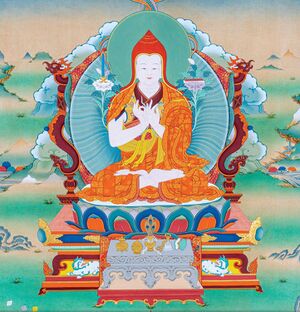Mipam's Doxographical Classification of Maitreya's Works
In his commentary on Maitreya's Distinguishing Phenomena and Their Nature, Mipam Gyatso, one of the most polymathic thinkers of nineteenth-century Tibet, explains that scholars differ in the doxographical classification of the five treatises taught by Maitreya as commentarial works on the Buddha's teachings. Some scholars, he reports, considered the five treatises to be parts of a single work, while others refuted such a position, saying that they cannot be coherent parts of a single work, as the five treatises diverge on the issue of whether there is only one vehicle or three vehicles which lead to ultimate liberation. The latter scholars then take the five treatises to be commenting on different turnings of the wheel of Dharma.
Among Maitreya's five treatises, some consider the first, the Abhisamayālaṃkāra, or Ornament of Clear Realization, and the last, the Ratnagotravibhāga, or the Ultimate Continuum, to fall within the Mādhyamika system and the middle three to fall under the Cittamātra system. Others maintain that only the Sūtrālaṅkāra, or the Ornament of Sūtra, belongs to the Cittamātra system and the rest to Mādhyamika thought. Still others argue that all the five treatises are fully works of Cittamātra thought or that of Mādhyamika.
Against such differences, Mipam states that it is indisputable that the Ornament of Clear Realization is a commentarial work on the Perfection of Wisdom taught in the middle turning and the Ultimate Continuum is clearly a commentary on the definitive teachings of the third turning, which deals with the buddha-nature. These two treatises also agree on the theories of the single spiritual gene and the single vehicle, which accords with the Mādhyamika thought. In contrast to these two, the Ornament of Sūtra is a commentary on other sūtras, and it clearly presents theories aligned to the Cittamātra thought, such as the acceptance of more than one spiritual gene and vehicle to ultimate liberation.
The two treatises, Distinguishing Phenomena and Their Nature and Distinguishing the Middle and Extremes, deal with the profound and vast aspects of general Mahāyāna thought and therefore cannot be categorized as belonging to either Cittamātra or Mādhyamika thought. They deal with topics which are common to all adherents of Mahāyāna. While Distinguishing the Middle and Extremes primarily discusses the vast aspects of the Mahāyāna path, Distinguishing Phenomena and Their Nature discusses the nonconceptual wisdom of the union of the two truths, which is the essence of the Mahāyāna teachings. Because of the profundity of the topics that Distinguishing Phenomena and Their Nature and the Ultimate Continuum deal with, Mipam reasons that these two treatises are considered to have been protected and thus their texts unavailable until Maitripa rediscovered them from a stūpa after seeing a light shining from a crack in it. When Zhama Lotsāwa Senge Gyeltsen translated Distinguishing Phenomena and Their Nature, the paṇḍita is said to have only spared one page at a time and advised the translator to strongly cherish them as the texts were rare.
Weekly quote
~

